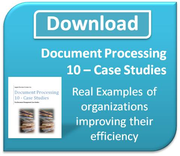Every business experiences document workflows. They are the way information moves between employees internally and suppliers and clients externally. They have a direct impact on business revenues and results.
They are unseen since they are not documented or understood very well. The information flows in a business are simply seen as a part of doing everyday work. Sometimes individual components of these flows are looked at as a way to administer costs and potentially to save money. 
Consider printing costs as an example. Many businesses have started to look at the amount of paper they produce and the cost of the tools used to do so. This has led to a process of analysis that has seen businesses consolidate print devices, look for best cost/performance equipment and establish print management strategies for employees. This is an excellent way to drive unneeded costs out of a business if done right.
Unfortunately, analysis like the print studies above only deals with a very small piece of the overall costs of document workflows. Recent work done by the Gartner Group has shown that there are four primary areas where document workflows impact an operation and it is through attacking these that substantial gains can be achieved.
-
The hard costs of copiers, printers, paper, and supplies make up only 10 percent of the total cost of a firm's document output. The other 90 percent is largely attributed to document management processes involving a firm's most valuable asset—its workforce.
-
The average office worker spends between 30 minutes to 2 hours per day searching for documents, which is 400 hours a year per employee. The average attorney spends up to three hours per week searching for files. Clerical staff spend another five hours per week searching for the same information.
-
The cost of maintaining an annual four-drawer file cabinet, including employee hours, is between $1,500 and $4,000. Each file cabinet costs between $350 and $500 and takes up 10 square feet of office space.
-
The typical office document is copied, either physically or electronically, an average of nine to eleven times at a cost of $18.
The tools to address many of the components of an operation which contribute to these costs are available to any size of business. Unfortunately, due to the early stated lack of recognition of the importance of workflows institutionalizing costs of operation, projects designed to addresse these issues are often shelved as not high priority work.
How many times has a document management project been considered in your company or organization?
Recently, a department manager in a major local institution told us that their organization had been considering adopting a structured electronic filing system for over ten years but that he does not think one would be in place before he retires. He sees benefits for his department he would like to obtain. His solution is to look for a smaller, departmental solution (maybe even cloud based) that he might be able to put in place before he retires so he can leave a more efficient and productive operation to his succesor.
Consider the graphic above with regards to how much potential is being left on the table by that organization.
Work processes are the real tools which every organization depends upon for success. Often they have grown through a series of ad hoc decisions designed to address a specific situation or case. Too often they get institutionalized in a way that continues them when the case is no longer applicable. Of course many work processes are valuable guides for employees to carry out their work and to ensure that proper procedures are followed. The challenge is to determine which are the good ones and which are the ones to let go of. In abscence of any review then the status quo will prevail.
Sometimes the simple changes in a workflow can be the things which bring the best gains. Eliminate a single step. Reduce the number of copies of forms that get circulated. Avoid printing and deal with an electronic copy of a document for processing. Each of these can be small in scope but big in impact if applied properly.
Addressing the components of the big portions of the document workflow process equation are the places where big gains in cost and efficiency can be made. Perhaps it is time to focus on the fourty seven percent portion of the activities shown in the graphic rather than the ten percent. Better still consider a plan to look at all of the components incrementally over time.
Where are you starting to look at your document processes? What impact could you achieve?
Lee K
Photo Credit: SOURCE: ALL ASSOCIATES GROUP




